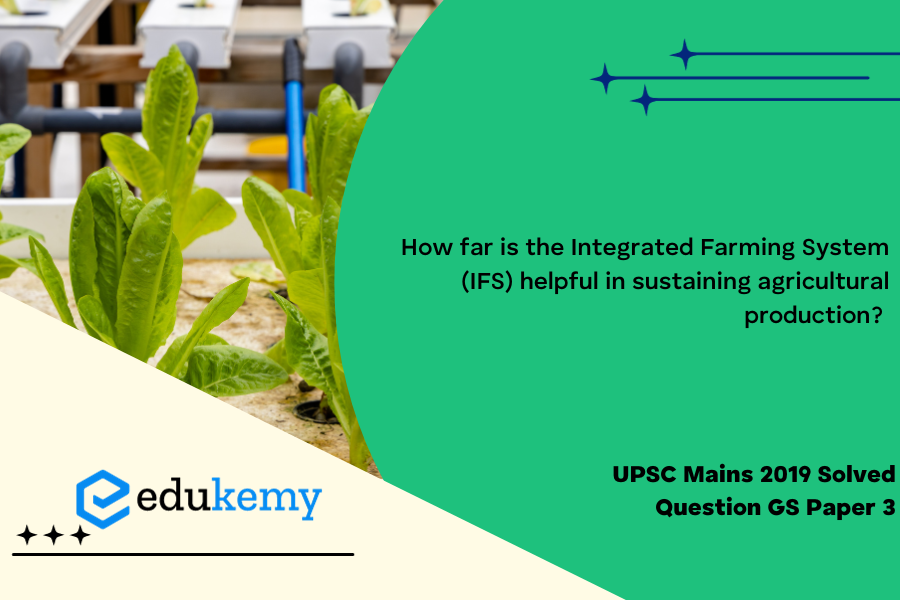The Integrated Farming System (IFS) has emerged as a transformative approach in agriculture, offering a comprehensive and sustainable solution to the challenges faced by traditional farming systems. By integrating various agricultural activities such as crop cultivation, livestock rearing, and aquaculture, IFS aims to optimize resource utilization and enhance overall farm productivity. This holistic approach not only promotes ecological balance but also addresses the multifaceted needs of farmers, ensuring a resilient and sustainable agricultural production system. The synergy between different components of IFS not only diversifies income sources but also minimizes risks associated with climate variability and market fluctuations. Moreover, the incorporation of organic farming practices and efficient waste recycling further contributes to environmental sustainability. This essay explores the extent to which Integrated Farming Systems have proven helpful in sustaining agricultural production by examining their impact on yield stability, resource efficiency, economic viability, and environmental conservation.
Tag: Major Crops – Cropping Patterns in various parts of the country, – Different Types of Irrigation and Irrigation Systems; Storage, Transport and Marketing of Agricultural Produce and Issues and Related Constraints.
Contents
Decoding the Question:
- In the Introduction, try to define the Integrated Farming System (IFS).
- In Body,
- Enlist goals of IFS.
- Elaborate how IFS helps sustain agricultural production.
- Mention some of the challenges associated with it.
- Try to conclude with suggestions and the significance of IFS.
Answer:
The Integrated Farming System (IFS) is a combined approach aimed at efficient sustainable resource management for increased productivity in the cropping system. The IFS approach has multiple objectives of sustainability, food security, farmer’s security, and poverty reduction by involving livestock, vermicomposting, organic farming, etc.
Examples of IFS include – Integrated Fish cum Pig farming, Integrated Fish Farming-Chicken, Integrated Fish farming-cum-Agriculture etc.

The major goals of IFS are:
- Maximization of yield for stable income.
- Achieve agroecological equilibrium.
- Controlling insect pests, diseases, and weeds.
- Reducing the use of agro-chemical inputs.
- Mitigation of the negative impact of agriculture or livestock on the environment.
IFS and Sustained Agricultural Production:
- Productivity: IFS provides an opportunity to increase economic yield per unit area by the intensification of crop and allied enterprises, especially for small and marginal farmers.
- Agriculture and Allied Activities: Cultivation of fodder crops as intercropping and as border cropping will result in the availability of adequate nutritious fodder for animal components like milch cow, goat/sheep, pig, and rabbit.
- Profitability: It can make the sector profitable by reducing the use of chemical fertilizer and recycling nutrients.
- Sustainability: In IFS, a subsystem of one byproduct works as an input for the other subsystem, making it environmentally sustainable. Moreover, IFS components are known to control the weeds and are regarded as an important element of integrated pest management and thus minimizing the use of weed killers as well as pesticides and thereby protecting the environment.
- Sustainable Soil Fertility: Organic waste recycling helps to reduce the problems of burning farm residue and increase soil fertility sustainably.
- Recycling: Effective recycling of products, by-products, and waste material in IFS is the cornerstone behind the sustainability of farming systems under resource-poor conditions in rural areas.
- Income round the year: Due to the interaction of enterprises with crops, eggs, meat, and milk, IFS provides a flow of money round the year amongst the farming community.
- Best utilization of small landholdings: Indian farmers in many regions such as in the north-eastern part, practice subsistence agriculture. They also have a rich traditional base in water harvesting, soil management, etc. which could be efficiently utilized under IFS.
- Meeting fodder crisis: Byproducts and waste material of crops are effectively utilized as fodder for livestock (Ruminants) and products like grain, and maize are used as feed for monogastric animals (pigs and poultry).
- Employment generation: Combining crops with livestock enterprises would increase the labor requirement significantly and would help in reducing the problems of underemployment and unemployment to a great extent. IFS provides enough scope to employ family labor around the year.
Some Challenges:
- Financial Support: This can be a game-changer for small and marginal farmers if financial support is available.
- Lack of Awareness: Most of the farmers are not aware of the benefits of IFS and extension services.
- Wheat-Rice Dominance: Mainly due to Minimum Support Prices farmers are hesitant for transition to IFS.
Therefore, promoting the Integrated Farming System is a vital and prominent solution for various agricultural problems especially farmer’s distress and improving the agrarian economy. It is high time that the government should promote and include farming communities in adopting IFS on a large-scale basis. India needs to adopt a “well designed” Integrated Farming System (IFS) to realize the vision of doubling farmers’ income by 2022 and having sustainable agricultural practices.
In case you still have your doubts, contact us on 9811333901.
For UPSC Prelims Resources, Click here
For Daily Updates and Study Material:
Join our Telegram Channel – Edukemy for IAS
- 1. Learn through Videos – here
- 2. Be Exam Ready by Practicing Daily MCQs – here
- 3. Daily Newsletter – Get all your Current Affairs Covered – here
- 4. Mains Answer Writing Practice – here


